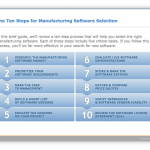ERP Evaluation
If you have ever been through the ERP Evaluation process, you understand the stress and pressure that is involved with selecting ERP Software. Selecting ERP software is like getting married. It can have a lot of unknowns. If you are just beginning the process, hopefully this article will provide you useful tools to streamline your efforts. An ERP Evaluation process takes time and the level of effort for properly selecting a provider and implementer can be tremendous. Here are some key things that you need to keep in mind.

A company only goes through an ERP Evaluation, on average, only once every seven to ten years. As such, they usually do not have resident experts in selecting software. Companies do everything from the extremely methodical analysis taking years, to the rash signing of the contract at a software convention with no investigation at all. How long should a proper search take from start to finish? If done in a thoughtful and yet expedient manner, it should take anywhere from three to six months. This really depends upon the number of candidate software vendors you are looking at and the degree upon which you investigate the implementers.
Reducing time on you ERP Evaluation
One of the best ways to keep the selection time down is to hire a coach. This coach can be a consultant, a seasoned colleague from a trade association such as APICS, or a Software Selection Service. In either case, they will be able to steer you clear of some of the obstacles that you are likely to run into. You want to choose someone that has a clear understanding of the ERP Software landscape. They must have been through several ERP Evaluations previously.
ERP Evaluation of Internal Processes
Once you choose your guide, you then need to look at your internal processes. Ideally, you can document your business and answer the following questions:
- What is the general industry of the business are you in? (ie. Manufacturing, Distribution, Professional Services, Retail, Property Management, or Construction, etc.)
- What are the things that distinguish your company from others in your industry? (ie. We have a retail store, we only sell through distributors, we manufacturer locally [or offshore], we have a strong customer support staff.) Don’t stop at one item, list out as many as possible.
- What is your budget? Are you looking at $50,000 or a $1,000,000 system? (Including implementation services and maintenance contracts)
- What does your current system do today that you want to keep as functionality and what does it do horribly that you want to improve upon?
- What are the key requirements for each of your various departments or functional areas? Both #4 and #5 should be documented in a spreadsheet with columns to indicate if they are “Must-haves” or “Nice-to-Haves.”
- What are the key business process that the system must enable? This is usually a flow from Order to Cash receipts (ie. Order, Inventory management, manufacturing, shipment, Invoicing, and finally payment) or on the other side, Procure to Pay (Inventory Shortage, Requirements Planning, Purchase Requisition, Purchase Order, Delivery, Stocking, Invoice Receipt, Accounts Payable) and ultimately financial reporting and analysis. Today, Customer Relationship Management (CRM) plays a large part in a business processes. This includes marketing to lead to account management to sales opportunity processes and product support with customer service processes. These processes should be mapped or at least documented to both a current state and a wishful future state.
With these ERP Evaluation factors, you now have the basis for an objective review. You can use the list of requirements for your analysis of the vendors. Often the requirements are sent out as a Request for Proposal (RFP) and the vendors are scored based on their requirements. The top two or three vendors are then invited in to demonstrate their product. Usually that begins with a walk through of the company and an extensive question and answer session so that the vendors can get a sense of who you are as a company and learn more about your requirements in preparation for the demonstration.
Using your process documentation, a script should be provided to the vendors who will be involved with the ERP Evaluation process. You can then use the script as an evaluation factor to compare the process flow of the various software candidates. The vendors should be held closely to the scripts processes. Many times, they will want to deviate to the latest release module that has nothing to do with your business, but looks “really cool.” Keep them on track.
Once all the demonstrations are completed, there is usually a sense of which vendor showed their software in a way the more clearly demonstrated that they could fulfill your requirements. You may have eliminated the last place contender, But this is not the decision point yet! Along with the demos, the vendors also need to provide a price proposal. These proposals should include the following:
- Software License cost
- Annual Support Agreement cost
- Implementation costs
- Estimate of hardware infrastructure costs
- Any other miscellaneous costs
You can also get references that you can either call or visit. In our experience though, these are only good to find out about the user’s experience with the software as they will tell you nothing but good things about the vendor, since they were selected because they are favorable references. But it might be good to hear about their implementation and their user’s reaction to the software.
Once you have all of these facts, you are ready to begin the next phase, which is the negotiation. Your evaluation still needs to look at the financial and contractual obligation you will be signing up for. At this point, you usually are down to the final two. One strategy is to play the vendors against one another, but this is sometimes not a good strategy. They are wise to this and will often dig in their heels. The best thing to do is to give them financial and contractual targets that will convince you that they are the right vendor for them. Don’t be afraid to ask for a lot more than you think they will give. They might just give it to you. Another key strategy is to negotiate at the end of the month. Ideally, the end of the month at the end of their fiscal quarter or year is ideal. The vendors are hungry to show the sale on their books and will often give deeper discounts.
Now with all the facts, you can make your choice. Once chosen, both you and the software provider will need to learn to compromise and respect the other’s view as you proceed to implement. Software can only be configured so far, before you need to change your processes. However, if you ran the evaluation process correctly, you will have selected the best fit for your business, so if there is any change to your processes, it will be by adopting the software system’s best practices. Thus, with your well-run ERP Evaluation, you have laid the groundwork for an even happier marriage!
Download the Ten Steps to Selection ERP Software now!

Download the Ten Steps to Selection ERP Software now!
ERP Evaluation



